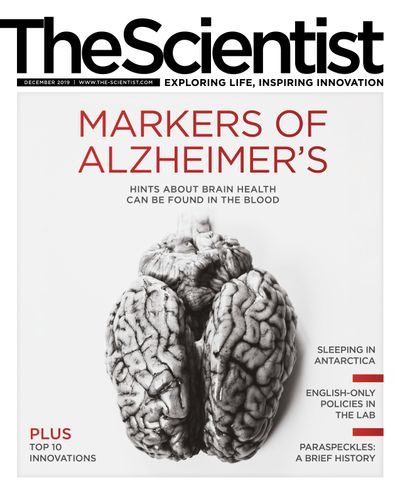ABOVE: © ISTOCK.COM, Design Cells
EDITOR’S CHOICE IN CELL & MOLECULAR BIOLOGY
The paper
C. Fecher et al., “Cell-type-specific profiling of brain mitochondria reveals functional and molecular diversity,” Nat Neurosci, 22:1731–42, 2019.
For many years, Thomas Misgeld, a neuroscientist at the Technical University of Munich in Germany, has studied mitochondria, often in the context of neurodegenerative and neuroinflammatory diseases. One thing he’s learned is that mitochondria in different cells or cell types, or even in different parts of the same cell, can behave quite differently. “Mitochondria are not as uniform as I always thought,” Misgeld says.

He wanted to develop a tool to capture that diversity. Taking inspiration from a decade-old technology called RiboTag, developed by researchers at the University of Washington (UW) to isolate ribosomes, Misgeld’s approach involved creating a line of mutant mice called MitoTag. These animals carry a gene that encodes a mitochondrial outer membrane protein tagged with green fluorescent protein, but as with RiboTag, the fluorescent fusion protein is only produced in the presence of an enzyme called Cre recombinase. Crossing the MitoTag mice with animals that express Cre recombinase in one of three types of brain cells, Misgeld and his colleagues were able to label only the mitochondria from those cell types. They then sacrificed the mice and used antibodies to isolate tagged mitochondria from their brain tissue.
Comparing protein levels in these three cerebellar cell types—excitatory neurons called granule cells, inhibitory neurons called Purkinje cells, and nonneuronal cells called astrocytes—Misgeld’s team looked for notable variation. Among these few cell types, “that already gives you variability in about 10 percent of the proteins that people believe make up a mitochondrion,” says Misgeld. If the analysis were expanded to all the different types of cells in the body, “you could imagine that the variability probably comprises a significant part of the mitochondrial proteome.”
While proteins involved in many critical biological pathways such as the electron transport chain were consistent across mitochondria from different cell types, those for other seemingly important processes, such as calcium handling, varied. For example, granule cells had noticeably higher levels of the mitochondrial calcium uniporter (MCU) complex than the other two cell types. And sure enough, the mitochondria isolated from granule cells showed more-efficient uptake of calcium in vitro. Misgeld notes that such variation doesn’t necessarily translate to functional differences in vivo—if, for example, Purkinje cells need less MCU than granule cells to get the same amount of calcium because it’s more concentrated at the site of uptake.
Purkinje cell mitochondria showed enriched production of Rmdm3, which binds mitochondria to the endoplasmic reticulum (ER), and electron microscopy confirmed that Purkinje cells had more mitochondria-ER contacts than granule cells or astrocytes. Meanwhile, the proteome in astrocyte mitochondria suggested the cells may break down lipids faster than their neuronal neighbors, a finding supported by in vitro assays of lipid metabolism in the isolated organelles.
“I think it’s a solid paper,” says molecular biologist David Morris, an emeritus professor at UW who helped develop RiboTag. He adds that the potential to cross the MitoTag mice with murine models of disease provides a new way to interrogate the mitochondria’s involvement in various disorders. “It should be a very useful tool.”
Jef Akst is the managing editor of The Scientist. Email her at jakst@the-scientist.com.
Interested in reading more?







